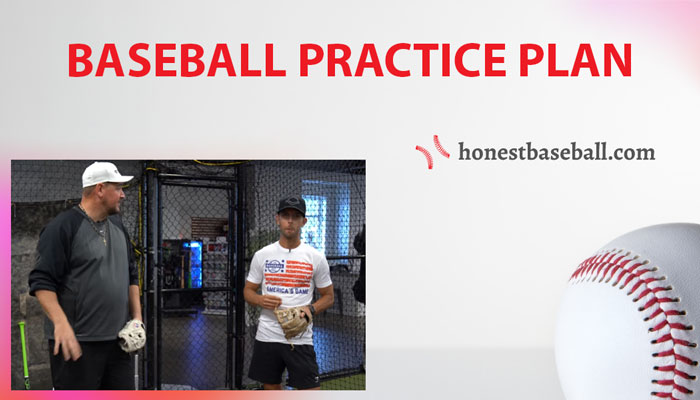Last Updated on September 12, 2023
You have often heard the expression “Practice makes a man perfect”. And if it has anything to do with baseball, you have no choice but to put in the hours of practice necessary to become a successful player. So a baseball practice plan is a must.
Creating a baseball practice plan is a great way to stay on top of all you need to do in order to improve as a player or even a pinch hitter.. For example, a specific ground ball drill, batting practice with several baseball bats, and practice pitching alone should be included.
When coaching your players, you should make the practice more competitive, demanding, and rapid. This allows your players to enter a game where they can unwind. This will help your players improve.
In this article, I will walk you through some of the most influential baseball practice plans for keeping your team engaged and focused during a practice session. The techniques listed here are helpful for any team, whether a young club learning the basics or a junior high squad aiming for college or the professionals.
Objective
First, you need to understand the objective of the practice. What am I hoping to achieve by doing this practice?
A practice plan without a goal is like a ship without a rudder. This was something I had to learn the hard way. Let me be clear: I do not want you to make the same mistake as me. When I first began coaching, I had no idea how to start training my squad. As a consequence, we faced a heavy defeat.
You can make a checklist of the skill sets, scenarios, and plays you want to cover. Then prepare an objective index for each of the first five practices based on what you prioritized.
It often takes more time than you expect to practice specific skills. Therefore after each session, you may adjust the goals for the following session. Assuming you are like me, you will not be able to meet most of the plans for the last practice.
In general, it always takes longer than I think it will, but I am at least postponing things that are not as important. The way I see it, this is an excellent foundation for us to establish.
Why You Should Have a Baseball Practice Plan
If you are the coach, you should spend approximately an hour in the morning noting down what the team will do that day. Additionally, you may send a pre-practice email or WhatsApp message to all your players.
They will know that you are passionate about your role and want to make the practice session more enjoyable.
A prepared coach has a better chance of getting the most out of his players, both physically and mentally.
Having a baseball practice plan template on hand helps increase the morale of your players. It might be the spark for your team to finally achieve the success you have been seeking for so long.
How Do You Create a Successful Baseball Practice Plan?
The first step in creating a reasonable baseball practice plan is recognizing the need to do a practice plan for baseball. Too many coaches just go with the flow.
They just show up at the pitch with a vague idea of whatever they want to do that day. As a result, players get bored, and their time is wasted due to inefficient procedures. Evaluate the types of work that your team requires and then create a realistic strategy to satisfy those requirements.
A well-thought-out plan for every practice session includes a list of exercises, their durations, and the players who are partaking in them.
Now, let us consider some of the particular aspects and activities you may use to improve your indoor baseball practice plan.
Equipment for Baseball Practice Plan
Of course, you need equipment to practice baseball. If you have this equipment, it will allow you for more adaptable sessions that can encompass a variety of drills. Here are five items that you should keep on hand.
Baseball in Gallon of Buckets
It is best if you can get as many of these as possible. In an idealistic situation, each coach would have one or even two to keep the right amount of baseballs. This enables multi-activity practices to go smoothly.
A better supply of baseballs also means that players will waste less time seeking loose balls throughout practice. It can be done between intervals, after practice, or at a suitable time by trainers.
The most time-consuming activity in practice is kids rushing after balls. You can use these buckets as mobile seats.
Throw Down Bases
You can make small diamonds at any time and in any place. You can use them in place of cones to provide players with the natural sense of utilizing a base. Plus, if you are practicing numerous infield exercises and require more than the conventional four bases, it provides a more flexible practice arrangement.
Cones
You will see football coaches using the 8-inch cones, which are the most suitable. Unlike stand-up cones, they are not easily knocked over. Preparing for a drill is easier when players know exactly where they are supposed to stand and what they should do.
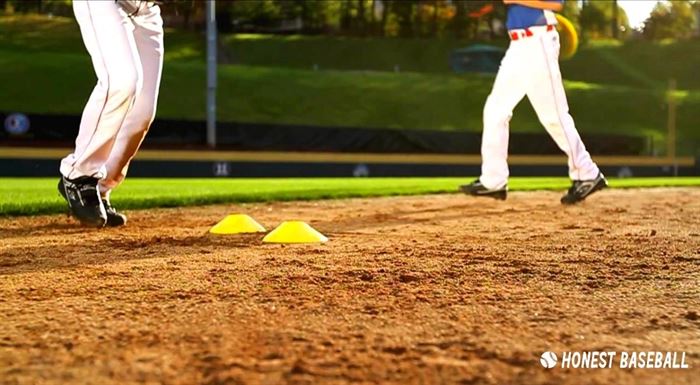
Wiffle Balls
Every excellent batting trainer has an ample supply of this essential equipment. They allow for many swings to be completed in a short period.
Wiffle balls are easy to throw and do not endanger the pitcher’s arm. Wiffle balls do not fly or fall, and they are easy to collect for different swings.
You can also use Batting Tee and Muhl balls. This equipment will significantly increase your bat swing speed.
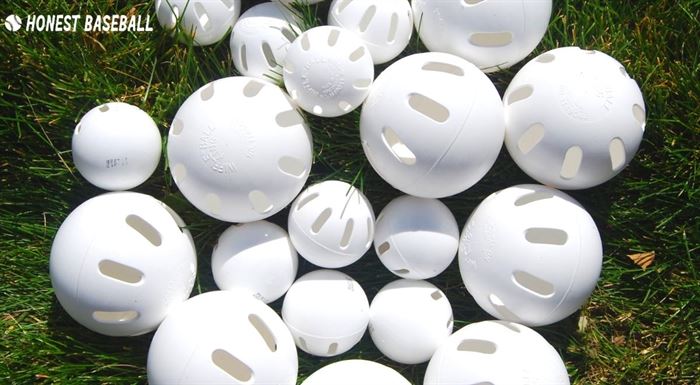
In the racquet sport, pickle balls are utilized, and some batters love the sound of them hitting off the bat more than others. Aside from that, they are significantly more convenient to throw.
Catcher’s Gear
The school or league often provides catcher’s gear. This equipment becomes more important as kids grow and develop their pitching skills. Most exercises do not need wearing them all, but having an extra pair available is a smart move.
Five Elements of a Great Baseball Practice Schedule
Plans for baseball practice are as diverse as the players’ skill sets, physiques, and talent levels. As you know, College baseball practice schedules heavily vary from Little League ones.
Indoor baseball practice programs, on the other hand, indoor baseball practice programs offer a smaller selection of exercises to choose from. Many effective practice plans follow a few basic principles, though.
- Warm-Ups
- Customized Drills.
- Team Practice
- Fun Practices
- Water Gap
Warm-Ups
Good warm-up drills are a must. Warm-ups keep athletes moving and heated, reducing injuries and increasing participation and attention.
Regardless of the day’s events, these early activities help athletes get into a workout mood. Note that your players do not have to run to the field 100 times.
While you may establish an image as a fearsome and dominant coach, doing so every session is not the most excellent use of your time in the long term. Using warm-up routines that concurrently condition and improve speed and strength is a smart tactic.
1. Light Jogging, Then Dynamic Stretching
Purpose: Warm-up players to avoid injury.
Implementation: Coaches have a variety of methods for warming up their athletes. When it comes to pre-game warm-ups, most trainers prefer to use dynamic stretching instead of static stretching.
You want to target all major muscle groups and provide enough opportunity for athletes to prepare psychologically.
2. Dynamic Warm-Up
Rounds of dynamic workouts are a fantastic way and get everyone warmed up and moving. Dynamic exercises provide players with mild cardio and stretching, which are great for physical and mental preparation.
3. Stretching
A rigorous stretching regimen before practice and play are crucial for all ages.
Kids may not even need to stretch. Their bodies are fluid and relaxed from dawn to dusk. But do not forget to stretch your 12-year-old athletes. You will be influencing their sporting habits for the rest of their lives. Good habits should be part of your baseball training.
Stretching is a great way to get your squad engaged and set for training.
So you can maximize practice time while building mental and physical power in your kids on game day.
Stretching techniques to include in pre-game practices include the following:
- forward lunges
- side lunges
- crossover toe touches
- lotus stretch
- forward seated bend
- side seated bend
- knees to chest
Stretching is a great way to examine practice material. To improve their baseball performance on the field and in the batter’s box, have them rehearse a visual picture of their game.
Baseball Skills Drills
These are the foundations of the first baseball training plan. They allow players to work on basics and skills. These are also called position-specific drills.
Skill-specific exercises include infield and outfield, throw or catch, pitcher, base running, and batting practices. These activities help each athlete build solid habits and muscle memory.
However, there is one critical limiting aspect about which exercises you pick. This is determined by the number of coaches who regularly come to inspect the players and can be depended upon.
In such cases, extra team exercises are needed to keep everyone motivated. With an additional trainer plus just a few volunteers, you can give players more one–on–one attention and conduct a more comprehensive drill.
Target Hitting
Purpose: Use “soft” hands to improve your bunting skills.
Tools and Setup: Hoops, baseball bats, and baseballs. Hula hoops should be positioned next to home plate and at the first and third bases.
Implementation: The pitcher will deliver the ball to the batters at the plate. Each hitter will try to smash the ball close or into the assigned hoop. This is an excellent method to practice bunting control.
Team Practice
Team practices involve the complete team and emphasize teamwork. Players learn teamwork and their roles within the squad.
You should limit the number and kind of team exercises you employ in a single session. Since these activities often result in players queuing up, they might reduce player involvement. It is good to shorten this wait time.
Aside from promoting teamwork, team exercises also imitate real-life game circumstances. Having all attention on the active player enhances the motivation and drive to do well. Nobody likes to embarrass themselves in front of their teammates or coaches.
2-1 scrimmage Drill
Purpose: This exercise shortens a standard scrimmage, placing tremendous pressure on the hitter and pitcher.
Tools and Setup: Bat, baseball, gloves, helmets, and baseball field.
Execution: Determine the batting order for each player. This exercise shortens the scrimmage and enables you to go through more hitters at the same time. Except for the count, it is a standard scrimmage.
With no margin for a mistake, the pitcher and the hitter will go at it with full intensity. Furthermore, this drill instills in athletes the mindset that they will get a strike.
Fun Practices
Although that is referred to as the “fun” category, it merely refers to exercises that assist the team to relax and remind them why they play sports. Fun drills might be as simple as a team hitting at the end of training or as innovative as a made-up activity that everyone likes.
These exercises are generally kept until the completion of long sessions when attention is fading after a full day of training. With younger teams, notably Tee Ball, you have greater latitude and may do more exercises.
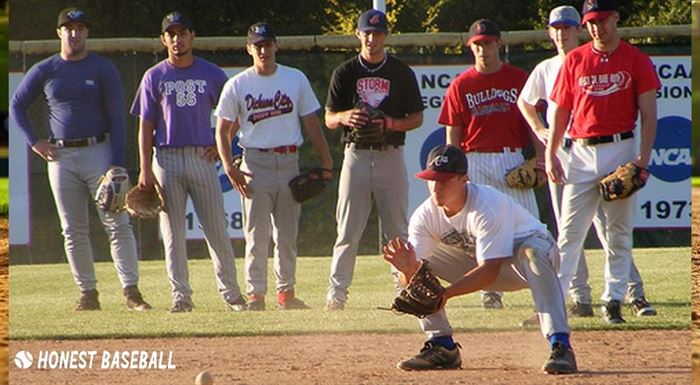
500
Purpose: A fun team game. This is a timeless classic which has established a standard on baseball pitches all over the world.
Tools and Setup: You can play a full diamond on a mini diamond. Bat, gloves, baseball, and four bases are the equipment you need,
Implementation: All players save one (the batter) should be evenly spaced throughout the field. The coach throws to the hitter. Defensive plays are scored.
Multi-hop: 25 points. One-hop: 50. Catching the baseball before it touches the ground: 100 points. This is how the rules work. The next batter will be the first outfielder to score 500 points.
Water Gap
Water gap and refocusing are sometimes ignored by amateur coaches, even though they are an essential part of every baseball session. Do not be one of them.
On a more serious note, dehydration is a significant problem, and you should always take your player’s safety first. Maintaining a healthy hydration level amongst your team members will help their overall health and performance.
Baseball sessions often last between an hour and two hours daily. Typically, a two-hour session will include at least two water intervals and no more than four, although this varies from coach to coach.
Weather, drills, and player age all have a role in how much water is required during practice. Water breaks also allow coaches to monitor progress and assign responsibility for the following round of activities.
Baseball equipment is susceptible to the effects of the weather. In the rainy season, your gloves are the most vulnerable. You need to know how to dry a wet baseball glove in this case.
Infielder Drills
Infield actions happen in a glimpse. So, infielders must be quick to respond. The infielder must be fast off the mark after the batter makes contact.
Infielders should practice spotting ground balls each day to improve their hand-eye synergy. On defense, infielders must have a bent wrist and fingers pointing downwards.
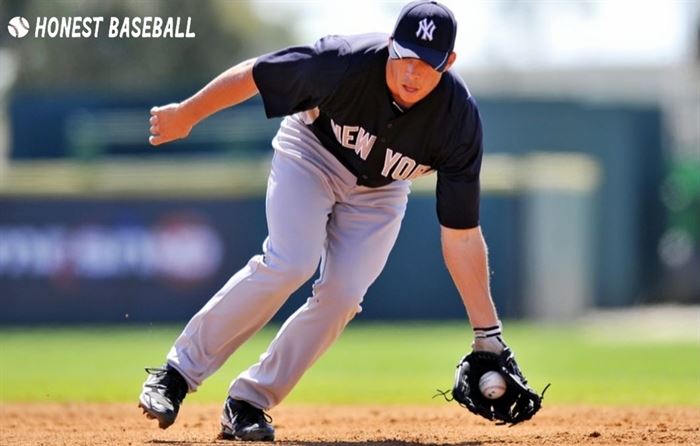
Hot Shot Drill
The hotshot drill involves all players, the speed is fast, and the focus of this drill is fielding the grounders,
Requirements for this drill are-
- Infield position players
- Buckets of baseball
- A ground ball hitter
- Ball feeder in the pitching machine
- 4 Buckets
Coaches, players, or anybody can be the ball feeder. To keep things going, they will throw balls to the batter. Infielders are sprayed with ground balls as the batter moves across the field.
After playing the ball, the players generally deposit it in a bucket at their base and rush back to the line. When the batter is out of baseballs, the infield players rush to fill their buckets and begin the round again.
In baseball practice exercises, this is about as straightforward as they get. If you execute it rapidly (a hit roughly per 3 seconds), you can get every infielder to hit approximately ten ground balls in less than 20 minutes. It works for catching fly balls too.
Short Hop
To start short hops, I advise you to work from the ground up. It is simpler to adapt to a terrible hop that leaps than one which remains low. The players should keep their head and eye behind their gloves. It will not only give them protection, also it will help them see the ball better.
Start the practice with the infielders on their knees and without their gloves. Players should line up in pairs, approximately 10 feet apart, across from each other. The following exercises are to be performed eight times each by the partners in alternately throwing firm but not overpowered short hops:
- Glove side
- Backhand
- Straight on
Repeat the short hop twice. Once without a glove, and once with a glove, in the standing ready posture.
Double Barrel Fielding Practice
After finishing the short hop practice, a quick break into a double-barreled infield should be given to the infielders. There must be either two instructors or two players involved in this exercise. The drill will continue for a total of 15 minutes, following the template:
First Round: 5-3, 6-4-3 (no throw), and 4-6-3 (no throw)
Third basemen in this round throw the baseball to first base. Shortstops will work on footwork and throws as the second infielder in preparation for a double play that will not be completed.
Second round: 5-4-3, 6-2
During this session, the second basemen attempt to complete double plays and return third-base. The shortstops simulate a runner and try to score by playing and throwing to home plate.
To ensure your safety, continuously diversify your ground-ball strikes. By doing it this manner, the second baseman is not hindered by the shortstop’s presence while throwing to first base and taking an outfielder out of play.
Third Round: 3-6-3, 4-2, 5-2
A grounder is fielded by the first baseman, who then throws it to second before coming to the base to complete the double play.
Three Cone Fundamentals
As part of the Three Cone Fundamentals exercise, players should pay attention to the pre-pitch stride, fielding stance breakdown, and the footwork onto the first base.
During the Short Hop Attack drill
It is essential to maintain excellent footwork throughout the hop is essential and repositioning your body before throwing during this drill.
Dry Action Cone drill
To finish off, this drill stresses good footwork and approach for various ground balls.
Outfielder Drills
When creating outfield workouts for your athletes, please remember that they must practice ball tracing while running. Outfielders must improve their athleticism and decision-making ability to properly track down fly balls shot into the space and above their heads.
Ensure your athletes are not sprinting on their toes to avoid bouncing their heads up and down. It is challenging to keep track of the ball’s flight in this way.
Also, top players should be able to run to a location on the pitch without looking at the ball and then grab it in mid-air while on the move.
Would you like to look away from the ball while playing? No way. You are the fastest when you are in a conventional running position with your head down.
Have you ever attempted a run when looking up at the sky? It is sluggish and clumsy, making it challenging to catch fly balls.
Outfielders must be able to interpret or forecast the trajectory of the ball immediately away to take the fastest path. The ability to correctly estimate the ball’s flight trajectory improves their reach, allowing them to simply lay their head down and move faster.
Triangle Drill
The triangle drill can improve communication between players and pop-up priorities in the outfield. This practice, mainly with younger players, will enable them to develop confidence in going after balls outside their comfort zone.
To do so, divide the outfielders into three categories and place them at the cones, as illustrated in the diagram below. You can do this drill on either side of the field.
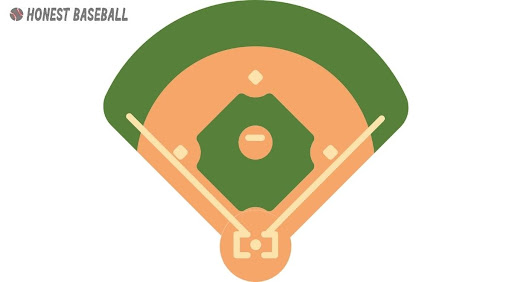
You may throw balls or even use fungo bats for the triangle drill. Throwing balls directly toward a player is an excellent way to mix it up. Check to see whether they are cheating by getting a head start.
Fly Ball
For 10-20 minutes, do the triangle drill. Then hit the outfielders with a combination of ground balls as well as fly balls, pushing them to come through the ball.
When they catch the ball, keep an eye on their body movement. Their body should not remain immobile but should instead move forward in the direction of the throw. They should catch the ball at eye level.
As these are essential exercises for the outfielders, the real challenge comes when they perform in the batting practice. The outfielders require a lot of live striking readings to enhance their ball reading and movement speeds. The batting practice is what keeps them sharp in an actual match.
L pattern drill
To help you better understand the situation, have your outfielders simply stand next to you. A wide receiver should run “L” patterns. Using this exercise, athletes learn to maintain appropriate angles while pursuing both the air and ground ball they are throwing.

Crow hop Drill
Roll the ground balls to outfield players. Have them go as near the ball as possible, field it on the run, perform crow hop, and finish it with a nice throw.
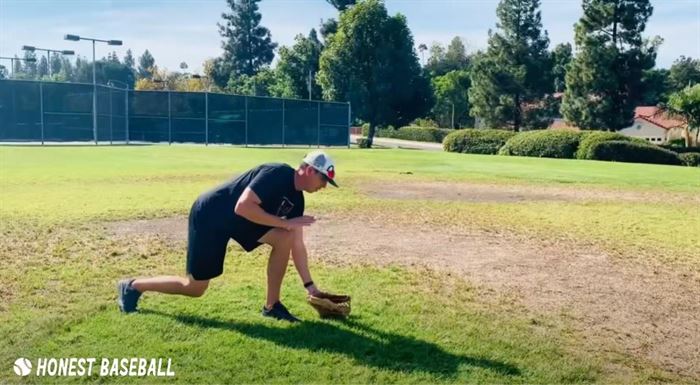
Catchers drill
It is impossible to have a successful baseball team without a good catcher. Helping your squad stay on track will be easier if you have an experienced catcher to back you up. A great catcher can help your team save runs by blocking balls and throwing the runner out.
Some basic drills for the catchers are;
- No gloves catch: Catchers should practice ball receiving with no gloves by receiving the ball underhanded. It enables the players to have calm and focused hands, as well as how to posture their hands correctly.
- Blocking: Give catchers short hops and make them practice blocking the ball.
- Receive, transfer, and footwork, then throw: Divide throwing practice into three parts so that catchers can be confident they are doing the proper thing at every stage of the game.
- Catching ground balls and pop-ups.
Drill for Blocking Ball
A team’s baserunning ability is hampered when a catcher hits the ground at home plate before approaching the plate.
You have to set up six baseballs approximately 10 feet apart from the baseline for this drill. This practice requires catchers to come equipped with all of their necessary gear.
In their position, they will move forward to it every baseball in a low crouch stance. The catchers will kneel in front of each ball to block a pitch.
The catcher will slide to the left two times, slide to the right two times, and drop downwards two times for the six balls.
Repeat this process three times, and your catchers will become exhausted. Although this exercise is designed to strengthen the legs, players must be able to block balls with proper form while doing it.
Drills for Pitch Framing
A ballgame’s result may be drastically altered by a well-framed pitch. It is like getting a third strike called on an outside pitch is a game-changing talent. Because the top catchers in MLB can steal strikes, your catchers must begin to improve this ability as early as possible.
This drill requires a plastic lid. When it comes to teaching pitch framing, these are excellent tools to have. So start putting aside the lids from the go-to container.
Toss these plastic lids/covers at your catchers as if they are small frisbees. The more catches they make, the better. It takes time to get used to them, but eventually, they become more comfortable as you keep the practice going on.
Pitch Framing drill teaches catchers to predict the ball’s travel and get to the point to catch the ball.
You will notice that your team steals more strikes if you instruct your player’s pitch framing.
Drills for Receiving the Ball
Catching bullpens regularly is a practical and straightforward approach to improving your catcher’s ball receiving, blocking, and pitch-framing skills.
Hitting Drills
Tee
You should put a lot of emphasis on tee work. Beginner players sometimes refuse to or cannot correctly use a tee, but they are critical.
See how enthusiastic they become when you tell them that major league players utilize tees daily. You can focus on the swing technique on the tee without worrying about time or choice.
Tee exercises and tee progressions come in a variety of configurations and styles. Using a tee increases the hitting ability and power of your players. Players can practice with a hitting net to boost their performance.
Soft toss
In this drill, tosses at a 45-degree angle are fed to players, and they must strike a fence or net with them. No, just because it is called the “softball” exercise does not mean you must throw a ball softly.
You do not want batters swinging at a falling ball. Feed the ball roughly at the belt buckle or the hitter’s front hip. This drill is all about timing.
Front toss
This drill is almost the same as soft toss. However, it is played behind an L-shaped screen. This drill teaches the same concepts as soft toss but from a more practical perspective.
One hand drills
This drill focuses on striking with one hand, starting with the bottom hand and working up to the top hand. This exercise focuses on isolating and developing the pulling and pushing muscles in the hands of the players.
Timing drill
This practice teaches players how to stride in the right direction and at the right time. Players should “stride” (approach the ball) three times. Your players will be better able to strike the ball as it comes to them if you have them repeat this exercise.
Rhythm Drill
Begin by having players rock four times. Put on four. Drills like these help players develop rhythm and lower-body engagement.
Power Drill
This practice teaches players how to maintain their balance, maintain their coordination and timing and how to utilize their lower body.
Launch point drill
Allow players to reach the moment in their swing when they are about to let go of their hands. Determine their “launch” point, feel relaxed in that stance, then toss the ball and swing from that point. It is important for baseball players to learn how to land in a good batting stance using this workout.
Contact drill
Players learn optimal placement with the contact drill. Instruct your players to freeze at the time of contact and then deliver the pitch. Players take a step back from the moment of contact before swinging their arms.
Hip drill
The ball should be thrown behind the player’s back to perform this drill. Make them tilt their hips and drag the ball as far away as possible. The goal of the hip drill is to improve a player’s hip flexibility.
Pitch selection Drill
Pitch or toss the ball to the batters. Allow them to take pitches and provide you with as much information as possible about the pitch, including the location, pitch type, ball, strike, swing, and do not swing.
Pitching Drills
The pitchers must be able to defend their place on the field. Bring them after the infielders’ practice session for the pitcher’s fielding practice to get them better at what they work.
Rotate between the pitcher and the first baseman when batting ground balls. The pitcher must be able to make good decisions. The pitcher is forced to protect the bag and field the ball. The pitcher must be able to make good decisions. This practice is not applicable in softball since pitchers are not obliged to cover first.
Ideally, the pitcher must cut up close to the foul line while covering first base in a game. If the pitcher crosses the foul line, he puts himself in danger of being hit by the runner.

In order to assist the pitcher in making it to first base, the first baseman offers a great underhand feed. The pitcher takes the pitch, touches the bag, and then curls away towards the fair zone.
Some of the basic drills for pitchers you can follow are as follows-
1) 1, 2, 3 Drill: Stop your players at the peak of the leg kick, and maintaining their balance is essential for this drill. Players should come to a complete halt at the striking spot.
Players should stop at their releasing point. Keep an eye out for these three essential stages in a pitcher’s delivery. This practice teaches isolated positioning.
2) Rhythm Drill: Tell your players to widen their feet. When it comes to pitching, a pitcher’s stride should match their height. Toss in the towel after four repetitions. It instructs players on how to engage the bottom half of their body and provides them with clear instructions on their target.
3) Separation Drill: During this practice, your players’ arms must swing in opposing directions from one another. Swinging should be tension-free. Throw on three after you have done this three times. It teaches players how to separate and time their movements properly. You may add a stride if you like.
4) Towel drill: Players should practice their delivery using a towel instead of a ball in their throwing hand. It instructs players on how to use their arms properly.
5) Reverse Drill: The pitch should be delivered by having players start at their point of release or finishing position, then flip their wind-up. Players are taught to “finish” the pitch by exhibiting the release point.
6) No release Dill: With either several baseballs or heavy balls, have players practice pitching without actually releasing the ball.
Seven and Ones
Pitchers and infielders are both engaged in this drill. Typically, it should be completed for around 10 minutes until the entire squad gets together for in-and-outfield.
During this exercise, seven fast-paced plays occur. In other words, each ball would be hit quickly just after the last play is finished, ensuring that the game flows smoothly.

Base Running
The baserunning practice, in my opinion, is often underestimated in baseball. One of the most crucial things to practice is, though.
The baserunning session should be practiced after the main practice session, depending on your player’s fitness.

Heading to first base
Make your players train by sprinting aggressively out of the batter’s box and going through the 1st base.
Players should practice “turns” at 1st base on batted balls towards the outfield to improve accuracy.
Leads and Steals
Prepare the players by having them practice main and secondary leads. Encourage players to practice obtaining strong hops on steals.
This is an excellent opportunity for the pitchers to improve their ability to keep runners and make pickoff throws. Baserunning stations should be used having a group at each base because there are subtle differences at each base.
Reads
Make the players improve their “reads.” Based on the scenario and defensive placement, reads involve responding to dirt and balls in play. There are big differences at each base. So use a group station at each base to account for these variations.
There is no need to rush the second-base runner if there are groups at every base. Each station operates as though there are no other players on the base.
Communication
Baserunning exercises should be as close to an actual game as possible. Take advantage of the first baseman, as well as the base instructors, to provide vocal and gesture signals.
Frequently Asked Question
1. How do you train a baseball at home?
If you are interested in methods to keep your game sharp until then, consider these five baseball exercises you can practice at home-
The Ceiling Flip Drills
If possible, choose a space with a high roof where you can do this task well. Attempt to grab the ball that has been thrown into the air while lying on your back. Playing baseball with adequate backspin allows athletes to improve their hand-eye coordination as well as their accuracy.
Toss the Ball Alone
Once again, a basic baseball practice to improve your swing efficiency and consistency.
Right-handed batters should go into their normal batting stance, with the baseball in their left hand, and swing. Using your opposite hand, repeat your swinging action and attempt to grab the ball as it flies.
Transition drills for outfielders
This drill may be done inside, but I prefer performing it outside. This one gives you the opportunity to practice appropriately placing and preparing your body to execute a great throw.
Gentle throw the baseball up and get behind it like you would in a real game. Once you have caught the ball, practice your throw while standing in your catching posture
Soft Toss / Tee Swings
Striking into a gentle pitch net is a tried-and-true method for improving your swing. Set up a net outdoors, with a hitting tee and a ball a few feet away.
Now, simply focus on hitting the ball towards the middle of the net with several full-speed swings. Every element of your swing, from hand and foot alignment, to the way you push the bat into the baseball, can be fine-tuned using this method.
2. What equipment do I need for Hitting lessons?
Here is a comprehensive list of the essential equipment that is needed for a baseball training session.
Batting Helmet
A batter’s helmet shields the player’s head closest to the thrower from being hit by the ball.
A baseball cap
Players wear hats to see better in the sun, something all baseball players do.
Uniform
Shirts and trousers are required attire for all players and coaches.
Baseball Cleats
In order to improve their traction, ballplayers wear special shoes consisting of rubber or metal.
Bat
Wooden or hollow metal baseball bats are used in the game of baseball.
Ball
Baseball is the name given to the ball that is used in baseball.
Gloves
Leather gloves are used to defend the player’s hands.
Catcher’s mitt
They have significantly bigger and more comfortable finger pockets than a typical fielder’s glove. Made out of leather.
Batting gloves
Gloves are used by batters to enhance grip and reduce shock while striking the ball.
3. What is your typical process for working with a new player?
I adhere to two rules.
1) Always Have a Good Time!
2) Try your best.
Whenever possible, I begin with a fast exploration session. We will spend a few minutes discussing the player’s standards and targets for the practice.
As the class gets underway, I begin with a vigorous warm-up exercise. I assist our athletes in developing their own “championship regimen” with dynamic stretching, movements preparations, and workouts.
This practice is meant to assist our athletes in training their flexibility to shift correctly, and also train them to improve significantly and limit the chance of injury.
After the light workout, we will either start with tee practice or soft toss workouts to review and validate the player’s throwing dynamics. I reassess the player throughout the session, giving feedback, exercises, and assignment recommendations.
Conclusion
Every baseball team must have a baseball practice plan to perform effectively during their games. You cannot expect to outplay a team that has a practice strategy, and you won’t.
Using the drills will help your players become more quick, innovative, and strong. Monitor the drills that you are making your players participate in.
These are the exercises that I use to train my athletes, and they have shown to be effective so far. I am hoping that yours will be as successful. Best of luck in your next game, and keep up the good work.

Hello everyone. My name is Jason Butler, and I live in California, America. I was a professional AAA Minor League Baseball player. I lost my chance of playing MLB for injury issues, but I did not lose my love for baseball. I attended the coaching training program and am now working as a coach in a small school in San Diego.
I always love to share my experience and knowledge if that can help you. Play baseball, and stay fit.
